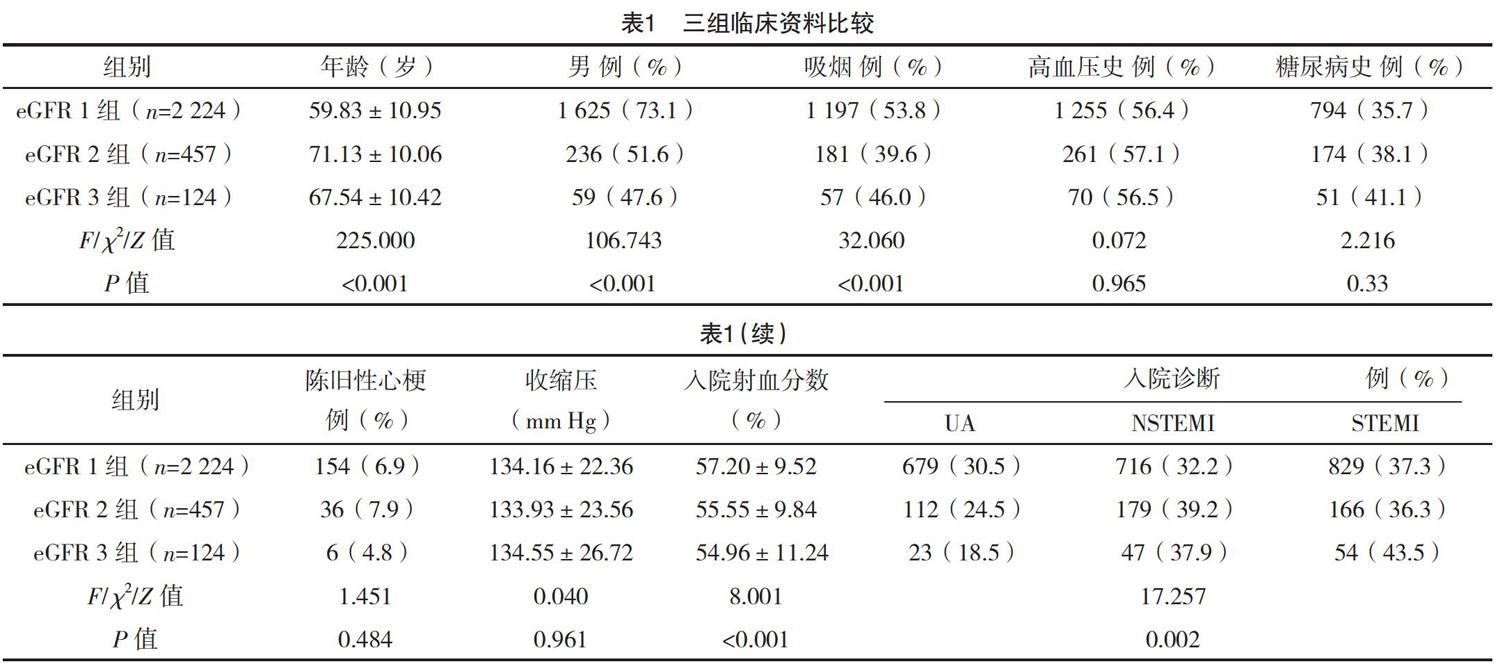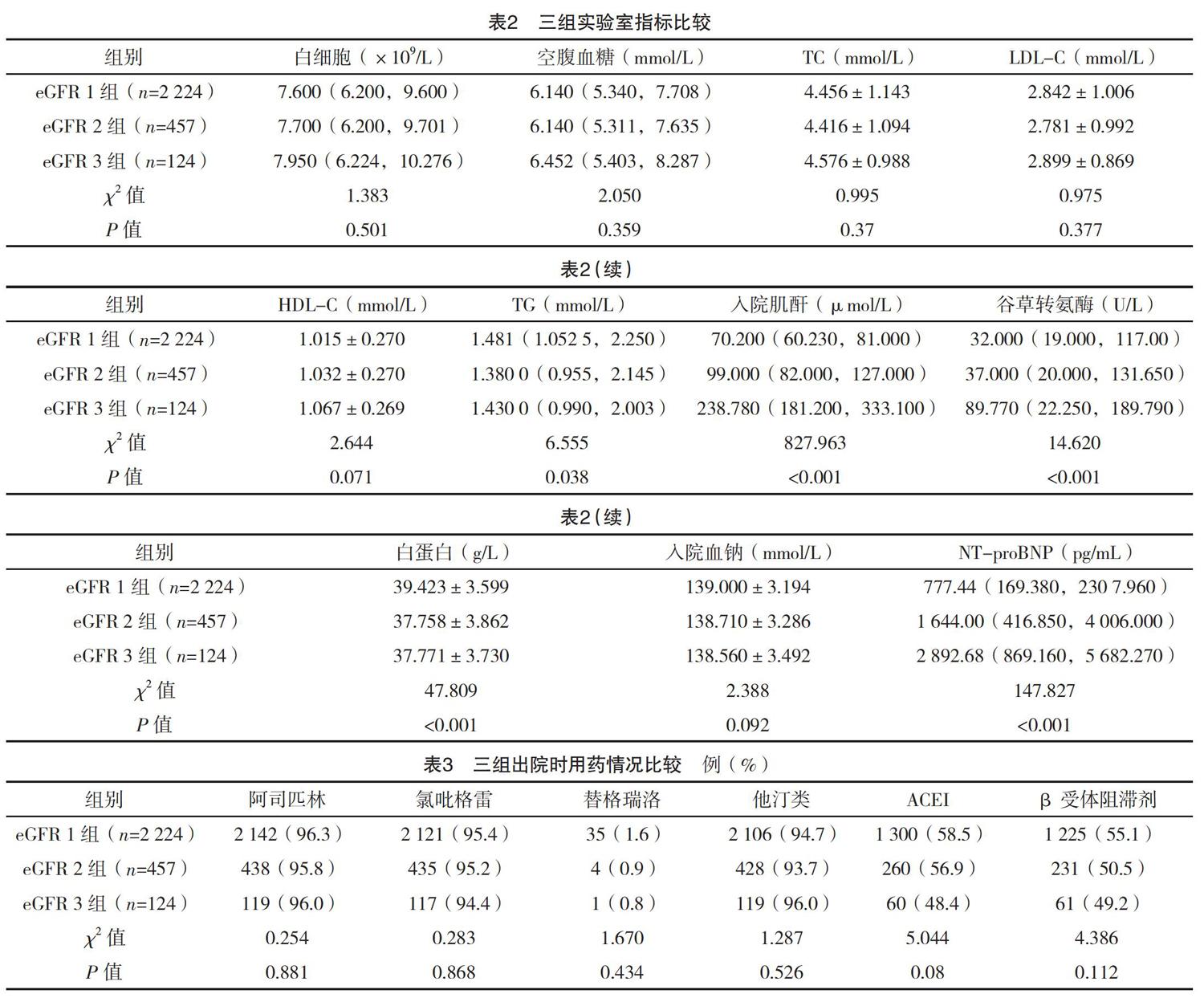肾小球滤过率对急性冠脉综合征并行PCI患者预后的影响
2020-05-07倪智航段玮丽武佳科温宗玉何东旭焦云娣孙志军孙兆青
倪智航 段玮丽 武佳科 温宗玉 何东旭 焦云娣 孙志军 孙兆青



【摘要】 目的:分析腎小球滤过率(eGFR)对急性冠脉综合征(ACS)并行经皮冠状动脉介入治疗(PCI)患者预后的影响。方法:采用前瞻性队列研究方法,连续入选本院2015年1月-2016年12月确诊ACS并行PCI的患者共2 805例。所有患者根据入院时eGFR分为eGFR轻、中、重度降低组,eGFR轻度下降组(eGFR 1组)为eGFR 60~89 mL/(min·1.73 m2)共12 224例,eGFR中度降低组(eGFR 2组)为eGFR 30~59 mL/(min·1.73 m2)共457例,eGFR重度降低组(eGFR 3组)为eGFR 15~29 mL/(min·1.73 m2)共124例。比较三组临床资料,随访1年,比较三组预后情况并分析eGFR和ACS行PCI患者预后的关系。结果:三组年龄、男性比例、吸烟人数、入院射血分数、入院诊断、入院肌酐、N末端脑钠肽前体(NT-proBNP)、甘油三酯(TG)、谷草转氨酶及血清白蛋白比较,差异均有统计学意义(P<0.05)。三组全因死亡率与心源性死亡率比较,差异均有统计学意义(P<0.05),其中eGFR1组全因死亡率与心源性死亡率最高。eGFR 15~29 mL/(min·1.73 m2)是ACS患者PCI术后1年心源性死亡的独立预测因素。结论:eGFR中、重度降低的ACS患者PCI术后死亡发生风险显著增加,eGFR 15~29 mL/(min·1.73 m2)是ACS患者PCI术后1年心源性死亡的独立预测因素。临床上可应用eGFR来预测ACS患者行PCI后住院期间以及出院后发生死亡和不良心血管事件的风险。
【关键词】 肾小球滤过率 急性冠脉综合征 经皮冠状动脉介入治疗
Effect of Glomerular Filtration Rate on the Prognosis of Acute Coronary Syndrome Patients with PCI/NI Zhihang, DUAN Weili, WU Jiake, WEN Zongyu, HE Dongxu, JIAO Yundi, SUN Zhijun, SUN Zhaoqing. //Medical Innovation of China, 2020, 17(01): 0-022
[Abstract] Objective: To analyze the effect of estimated glomerular filtration rate (eGFR) on the prognosis of acute coronary syndrome (ACS) patients with percutaneous coronary intervention (PCI). Method: A total of 2 805 patients diagnosed with ACS underwent PCI from January 2015 and December 2016 were selected in a prospective cohort study. They were were divided into light, moderate and severe eGFR reduction groups based on eGFR at admission. There were 12 224 cases in the mild eGFR reduction group (eGFR 1 group) of 60-89 mL/(min·1.73 m2), 457 cases in the moderate eGFR reduction group (eGFR 2 group) of 30-59 mL/(min·1.73 m2), and 124 cases in the severe eGFR reduction group (eGFR 3 group) of 15-29 mL/(min·1.73 m2). The clinical data of the three groups were compared. Followed up for 1 year, the prognosis of the three groups was compared and the relationship between the prognosis of eGFR and ACS patients underwent PCI was analyzed. Result: Age, male proportion, smoking number, ejection fraction, diagnosis, creatinine, N-terminal brain natriuretic peptide precursor (NT-proBNP), triglyceride (TG), glutamine transaminase and serum albumin of the three groups were compared, the differences were statistically significant (P<0.05). There were statistically significant differences in all-cause mortality and cardiogenic mortality among the three groups (P<0.05), among which the eGFR 1 group had the highest all-cause mortality and cardiogenic mortality. EGFR of 15-29 mL/(min·1.73 m2) was an independent predictor of cardiogenic death in ACS patients one year after PCI. Conclusion: The risk of death after PCI was significantly increased in ACS patients with moderate and severe eGFR reduction. eGFR of 15-29 mL/(min·1.73 m2) was an independent predictor of cardiogenic death in ACS patients one year after PCI. Clinically, eGFR can be used to predict the risk of death and adverse cardiovascular events in ACS patients during hospitalization after PCI and after discharge.
[Key words] Estimated glomerular filtration rate Acute coronary syndrome Percutaneous coronary intervention
First-authors address: China Medical University Shengjing Hospital, Shenyang 110022, China
doi:10.3969/j.issn.1674-4985.2020.01.005
急性冠状动脉综合征(acute coronary syndrome,ACS)是由于冠状动脉粥样硬化斑块不稳定、破裂或侵蚀,继发急性血栓形成,导致局部血管闭塞而发生的急性缺血事件,其发病率、致残率、死亡率呈逐年上升趋势,并且日趋年轻化,是冠心病患者的主要致死原因。目前经皮冠状动脉介入(percutaneous coronary intervention,PCI)治疗广泛应用于心肌梗死患者,PCI可以迅速开通冠脉闭塞血管,恢复心肌的灌注,从而显著降低ACS患者病死率,但研究显示我国ACS患者PCI术后的2年死亡率仍高达4.6%[1]。因此,对ACS患者进行正确的危险程度评估以及进一步寻找发现可以预测ACS患者预后的可靠生物标志物变得越来越重要。
血清肌酐是临床评估肾功能的重要指标,然而血清肌酐水平易受运动、饮食、肌肉容积等因素影响,故仅凭血清肌酐水平来判断肾功能,可能导致对患者肾功能损害程度的低估,因此目前用肾小球滤过率(estimated glomerular filtration rate,eGFR)来评估肾脏功能水平更趋于准确[2]。肾小球滤过率是指单位时间内通过肾小球滤过的血浆量,直接相关于有功能的肾小球数量,是评估肾脏滤过功能的最佳指标,是评价肾脏功能和肾功能损伤严重程度的重要指标[3]。以往研究显示,eGFR是冠状动脉疾病的独立危险因素;冠心病患者入院时的血清肌酐水平及eGFR值与不良的预后直接相关[4-5]。轻度肾功能下降被证明是独立于传统危险因素的心血管疾病死亡的预测因素。在一般人群中,中度eGFR降低是增加冠心病患者致死性心肌梗死的发病风险等。但当前关于eGFR与经PCI治疗的ACS患者相关性研究的报道较少,因此本研究以eGFR为指标,通过分析与ACS患者PCI术后发生临床终点事件的相关性,探讨eGFR和PCI术后的ACS患者预后的关系研究,旨在为此类患者的临床干预提供有关依据,现报道如下。
1 资料与方法
1.1 一般资料 采用前瞻性队列研究方法,连续纳入2015年1月1日-2016年12月31日于中国医科大学附属盛京医院心内科诊断为ACS且行PCI术2 805例患者。纳入标准:所有患者均符合2013年ACC/AHA制定的ACS诊断标准,包括急性ST段抬高型心肌梗死(acute ST-segment elevation myocardial infarction,STEMI)、急性非ST段抬高型心肌梗死(acute non-ST segment elevation myocardial infarction,NSTEMI)和不稳定型心绞痛(unstable angina,UA)[4];均行PCI治疗,PCI的选择策略、方法、血流动力学的评价符合现行指南标准[5]。排除标准:存在心脏瓣膜病、心肌炎、心肌病等其他器质性心脏病患者;自身免疫性疾病及结缔组织病患者;慢性感染患者;全身各系统肿瘤或存在严重的其他系统疾病者。根据入院时eGFR分为三组:eGFR 1组2 224例[eGFR>59 mL/(min·1.73 m2)],eGFR 2组457例[60>eGFR>29 mL/(min·1.73 m2)],eGFR 3组124例[eGFR<30 mL/( min·1.73 m2)]所有患者及家属均知情同意,并签署知情同意书,本研究获得中国医科大学附属盛京医院伦理委员会批准。
1.2 方法 详细记录入选患者的临床资料,包括年龄、性别、危险因素,既往疾病史、入院诊断、实验室指标、出院时用药情况。所有患者均在入院时采取静脉血样,并由本院核心实验室统一使用完全自动化的生物化学免疫分析仪(Ci 16200,Abbott,USA)测量血清肌酐值。2009年由慢性肾脏病流行病学合作研究组(chronic kidney disease epidemiology collaboration,CKD-EPI) 提出的CKD-EPI公式被认为是较MDRD公式有更高的精密度和准确度,且对心、脑血管疾病存在的风险有较好的预测能力,可弥补其他评估肾功能所应用方程相关的过度治疗或者降低诊断分期的缺点[6]。因此根据CKD-EPI公式分别计算eGFR。根据国家肾脏基金会指南中慢性肾病分期将所有患者分为eGFR轻、中、重度降低组[7]。eGFR轻度下降组(eGFR 1组)为eGFR 60~89 mL/(min·1.73 m2)共12 224例,eGFR中度降低组(eGFR 2组)为eGFR 30~
59 mL/(min·1.73 m2)共457例,eGFR重度降低组(eGFR 3组)为eGFR 15~29 mL/(min·1.73 m2)共124例。以患者出院为研究起点,出院1年后通过门诊、住院或电话联系的方式随访所有患者术后全因死亡(各种原因导致的总死亡人数)及主要心血管不良事件(心源性死亡、非致死性心肌梗死、非计划再次血运重建)。分析eGFR对全因死亡与心源性死亡的影响。
1.3 统计学处理 采用SPSS 19.0软件对所得数据进行统计分析,符合正态分布计量资料用(x±s)表示,组间比较采用独立样本t检验,组内比较采用配对t检验,多组間比较采用方差分析,不符合正态分布的计量资料以M(P25,P75)表示,比较采用Kruskal Wallis检验;计数资料以率(%)表示,比较采用字2检验,三组之间的生存分析比较采用单因素、多因素COX回归分析,以P<0.05为差异有统计学意义。
2 结果
2.1 三组基线资料比较 三组年龄、男性比例、吸烟人数、入院射血分数、入院诊断、入院肌酐、N末端脑钠肽前体(NT proBNP)、甘油三酯(TG)、谷草转氨酶及人血白蛋白比较,差异均有统计学意义(P<0.05)。随着eGFR降低程度加重,男性比例更低,射血分数、人血白蛋白降低,NT-proBNP的升高、血清甘油三酯增加。三组其余指标比较,差异均无统计学意义(P>0.05)。见表1~3。
2.2 三组术后1年随访情况 三组全因死亡率与心源性死亡率比较,差异均有统计学意义(P<0.05),其中eGFR1组全因死亡率与心源性死亡率最高。三组非致死性心肌梗死率与非计划再次血运重建率比较,差异均无统计学意义(P>0.05)。见表4。
2.3 eGFR与预后的关系 单因素分析显示eGFR 15~59 mL/(min·1.73 m2)与1年全因死亡及心源性死亡具有相关性(P<0.05);其中,校正了表1全部有差异因素(年龄、性别、吸烟史、入院射血分数、白蛋白、谷草转氨酶、NT-proBNP等因素)后,多因素分析显示eGFR 15~29 mL/(min·1.73 m2)是ACS患者PCI术后1年心源性死亡的独立预测因素(P<0.05)。见表5。
3 讨论
近年来,随着生活水平的提高及人口老龄化的加重,心血管系统疾病尤其是急性冠脉综合征的发病率逐年增高,肾功能不全的发病率也越来越高。本研究结果显示,随着eGFR降低程度加重,男性比例更低,射血分数、人血白蛋白降低,NT-proBNP的升高、血清甘油三酯增加,这与以往的研究结果一致[8-11]。这说明ACS合并肾功能不全的患者病情重,也是导致预后不良的原因。另外还有可能与治疗的副作用有关,如药物在肾功能不全患者体内蓄积的风险增加,在接受血运重建后更容易发生出血、造影剂肾病或原有肾衰竭加重等并发症,进而导致预后不良,增加心血管不良事件的风险。
目前由于eGFR降低引起的心血管不良预后的病理生理机制尚不明确。可能与以下几方面有关:(1)eGFR降低患者常合并高龄、高血压、糖尿病、血脂异常、高同型半胱氨酸血症等多种危险因素,这些因素加速了动脉粥样硬化的进程,同时增加了血栓形成发生的风险,使血管活性物质得到释放从而收缩血管,血流进一步减少、中断,导致ACS的发生[12-13]。(2)eGFR降低的患者因交感神经系统和RAAS系统的激活,导致高血压状态、氧化应激、钙磷代谢异常、贫血等因素出现恶性循环,进一步加重血管内皮损害,从而使冠状动脉粥样硬化斑块的形成和进展加快,血管重构及内皮功能损害共同参与了肾功能不全患者所能引发的血管并发症,从而增加了ACS患者心血管不良事件发生[14-16]。
(3)微血管内皮功能障碍参与肾脏疾病的进展,而微量蛋白尿是肾小球高滤过的标志,与内皮功能障碍相关[17]。(4)eGFR的降低与系统性炎症状态密切相关,肾功能不全患者的致炎症因子增加,导致心血管事件发生风险的增加[18-20]。
本研究基于行PCI术的ACS患者,比较不同程度eGFR患者的全因死亡及主要心血管不良事件的发生情况,这填补了以往由于错综复杂的各种原因所导致临床医生对此类患者的个体化治疗方案趋于保守上的空缺,并且包含了重度肾功能不全的患者,使治疗更加积极、规范,使ACS患者的诊疗更加完整,能更好地反映临床实际情况。本研究结果显示,随着eGFR的下降,ACS患者PCI术后1年全因死亡率及心源性死亡率升高有统计学意义。单因素分析显示eGFR 15~59 mL/(min·1.73 m2)与1年全因死亡及心源性死亡具有相关性(P<0.05);多因素分析显示eGFR 15~29 mL/(min·1.73 m2)是ACS患者PCI术后1年心源性死亡的独立预测因素(P<0.05)。在临床工作中需更加重视。
本研究为单中心的前瞻队列性研究,随访时间有待进一步延长,以及有待加入多中心大规模研究,并且只测量一次入院后的血清肌酐水平,并未动态监测肌酐指标的变化,以上因素造成的偏移今后需要进一步更大样本量的研究。
综上所述,ACS患者PCI术后1年全因死亡率及心源性死亡率随eGFR的降低而增加;同eGFR 30~59 mL/( min·1.73 m2)的患者相比,eGFR 15~29 mL/(min·1.73 m2)的ACS患者PCI术后1年心源性死亡发生风险显著增加,是ACS患者预后的独立预测因素。临床上,可应用eGFR来预测ACS患者行PCI后住院期间以及出院后发生死亡和不良心血管事件的风险,应尽早进行血清肌酐的监测并计算eGFR,评估风险-获益比,挑选最佳的治疗方案改善患者的预后。
參考文献
[1]中华医学会心血管病学分会介入心脏病学组,中国医师协会心血管内科医师分会血栓防治专业委员会,中华心血管病杂志编辑委员会.中国经皮冠状动脉介入治疗指南(2016)[J].中华心血管病杂志,2016,44(5):382-400.
[2] Fácila L,Núez J,Bodí V,et al.Prognostic value of serum creatinine in non-ST-elevation acute coronary syndrome[J].Rev Esp Cardiol,2006,59(3):20-216.
[3] Hawranek M, Gierlotka M, G?sior M,et al.Renal function on admission affects both treatment strategy and long-term outcomes of patients with myocardial infarction (from the Polish Registry of Acute Coronary Syndromes)[J].Kardiol Pol,2017,75(4):332-343.
[4] Kim I Y,Hwang I H,Lee K N,et al.Decreased renal function is an independent predictor of severity of coronary artery disease:an application of Gensini score[J].J Korean Med Sci,2013,28(11):1615-1621.
[5] Tonelli M,Muntner P,Lloyd A,et al.Impact of Age on the Association Between CKD and the Risk of Future Coronary Events[J].Am J Kidney Dis,2014,64(3):375-382.
[6] Cannon C P,Brindis R G,Chaitman B R,et al.2013 ACCF/AHA key data elements and definitions for measuring the clinical management and outcomes of patients with acute coronary syndromes and coronary artery disease:a report of the American College of Cardiology Foundation/American Heart Association Task Force on clinical data standards(writing committee to develop acute coronary syndromes and coronary artery disease clinical data standards)[J].Journal of the American College of Cardiology,2013,61(9):992-1025.
[7] Levine G N,Bates E R,Blankenship J C,et al.2011 ACCF/AHA/SCAI Guideline for Percutaneous Coronary Intervention:a report of the American College of Cardiology Foundation/American Heart Association Task Force on Practice Guidelines and the Society for Cardiovascular Angiography and Interventions[J].Circulation,2011,124(23):2574-609.
[8] Levey A S,Stevens L A,Schmid C H,et al.A new equation to estimate glomerular filtration rate[J].Ann Intern Med,2009,150(9):604-612.
[9] National Kidney Foundation.K/DOQI clinical practice guidelines for chronic kidney disease:evaluation,classification,and stratification[J].Am J Kidney Dis,2002,39(2 Suppl 1):1-266.
[10]李超,胡大一,王建旗,等.急性心肌梗死患者腎功能状态及对预后的影响[J].中国分子心脏病学杂志,2012,12(6):321-324.
[11] Hu L H,Zhang L J,Jin J T,et al.Analysis of the Clinical Characteristics of Patients with Coronary Syndrome in Different States of Renal Function[J].West Indian Med J,2015,64(4):357-361.
[12]朱慧楠,霍勇,蒋捷,等.非ST段抬高心肌梗死预后因素分析及合并肾功能不全的临床特征[J].北京大学学报(医学版),2008,40(5):533-537.
[13] Anavekar N S,McMurray J J,Velazquez E J,et al.Relation between renal dysfunction and cardiovascular outcomes after myocardial infarction[J].N Engl J Med,2004,351(13):1285-1295.
[14] El-Menyar A,Zubaid M,Sulaiman K,et al.In-hospital major clinical outcomes in patients with chronic renal insufficiency presenting with acute coronary syndrome:data from a registry of 8 176 patients[J].Mayo Clin Proc,2010,85(4):332-340.
[15] Kono K,Fujii H,Nakai K,et al.Composition and plaque patterns of coronary culprit lesions and clinical characteristics of patients with chronic kidney disease[J].Kidney Int,2012,82(3):344-351.
[16] Sarnak M J,Levey A S,Schoolwerth A C,et al.Kidney disease as a risk factor for development of cardiovascular disease:a statement from the American Heart Association Councils on Kidney in Cardiovascular Disease,High Blood Pressure Research,Clinical Cardiology,and Epidemiology and Prevention[J].Hypertension,2003,42(5):1050-1065.
[17] Sakamoto N,Iwaya S,Owada T,et al.A reduction of coronary flow reserve is associated with chronic kidney disease and long-term cardio-cerebrovascular events in patients with non-obstructive coronary artery disease and vasospasm[J].Fukushima J Med Sci,2012,58(2):136-143.
[18] Baigent C,Landray M J,Reith C,et al.The effects of lowering LDL cholesterol with simvastatin plus ezetimibe in patients with chronic kidney disease(Study of Heart and Renal Protection):a randomized placebo-controlled trial[J].Lancet,2011,377(9784):2181-2192.
[19] Stehouwer C D,Smulders Y M.Microalbuminuria and risk for cardiovascular disease:analysis of potential mechanisms[J].J Am Soc Nephrol,2006,17(8):2106-2111.
[20] Shlipak M G,Fried L F,Crump C,et al.Elevations of inflammatory and procoagulant biomarkers in elderly persons with renal insufficiency[J].Circulation,2003,107(1):87-92.
(收稿日期:2019-05-27)(本文編辑:田婧)
